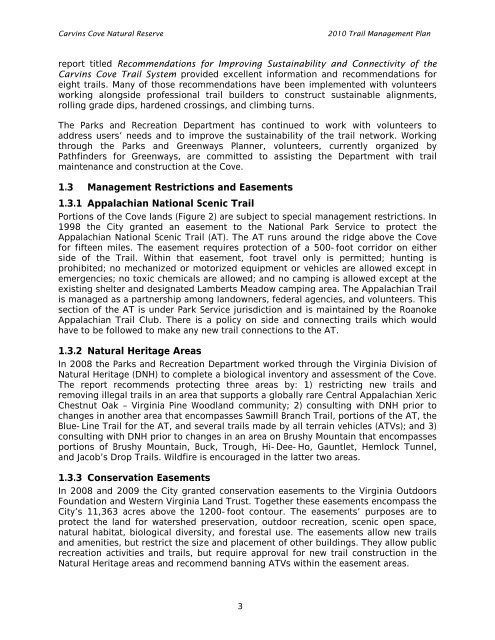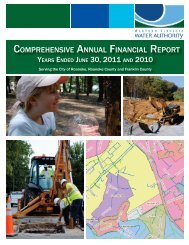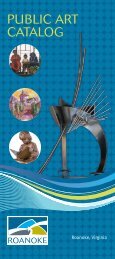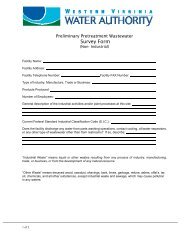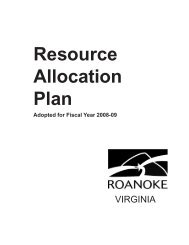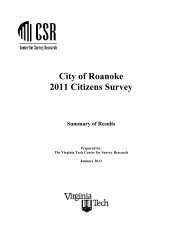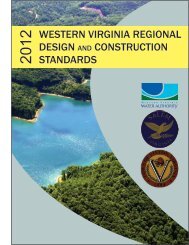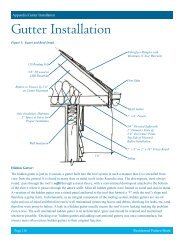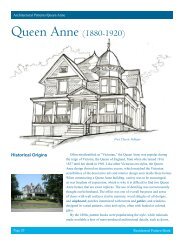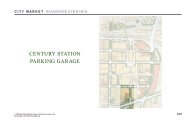Carvins Cove Trail Plan - Roanoke
Carvins Cove Trail Plan - Roanoke
Carvins Cove Trail Plan - Roanoke
You also want an ePaper? Increase the reach of your titles
YUMPU automatically turns print PDFs into web optimized ePapers that Google loves.
<strong>Carvins</strong> <strong>Cove</strong> Natural Reserve<br />
2010 <strong>Trail</strong> Management <strong>Plan</strong><br />
report titled Recommendations for Improving Sustainability and Connectivity of the<br />
<strong>Carvins</strong> <strong>Cove</strong> <strong>Trail</strong> System provided excellent information and recommendations for<br />
eight trails. Many of those recommendations have been implemented with volunteers<br />
working alongside professional trail builders to construct sustainable alignments,<br />
rolling grade dips, hardened crossings, and climbing turns.<br />
The Parks and Recreation Department has continued to work with volunteers to<br />
address users’ needs and to improve the sustainability of the trail network. Working<br />
through the Parks and Greenways <strong>Plan</strong>ner, volunteers, currently organized by<br />
Pathfinders for Greenways, are committed to assisting the Department with trail<br />
maintenance and construction at the <strong>Cove</strong>.<br />
1.3 Management Restrictions and Easements<br />
1.3.1 Appalachian National Scenic <strong>Trail</strong><br />
Portions of the <strong>Cove</strong> lands (Figure 2) are subject to special management restrictions. In<br />
1998 the City granted an easement to the National Park Service to protect the<br />
Appalachian National Scenic <strong>Trail</strong> (AT). The AT runs around the ridge above the <strong>Cove</strong><br />
for fifteen miles. The easement requires protection of a 500-foot corridor on either<br />
side of the <strong>Trail</strong>. Within that easement, foot travel only is permitted; hunting is<br />
prohibited; no mechanized or motorized equipment or vehicles are allowed except in<br />
emergencies; no toxic chemicals are allowed; and no camping is allowed except at the<br />
existing shelter and designated Lamberts Meadow camping area. The Appalachian <strong>Trail</strong><br />
is managed as a partnership among landowners, federal agencies, and volunteers. This<br />
section of the AT is under Park Service jurisdiction and is maintained by the <strong>Roanoke</strong><br />
Appalachian <strong>Trail</strong> Club. There is a policy on side and connecting trails which would<br />
have to be followed to make any new trail connections to the AT.<br />
1.3.2 Natural Heritage Areas<br />
In 2008 the Parks and Recreation Department worked through the Virginia Division of<br />
Natural Heritage (DNH) to complete a biological inventory and assessment of the <strong>Cove</strong>.<br />
The report recommends protecting three areas by: 1) restricting new trails and<br />
removing illegal trails in an area that supports a globally rare Central Appalachian Xeric<br />
Chestnut Oak – Virginia Pine Woodland community; 2) consulting with DNH prior to<br />
changes in another area that encompasses Sawmill Branch <strong>Trail</strong>, portions of the AT, the<br />
Blue-Line <strong>Trail</strong> for the AT, and several trails made by all terrain vehicles (ATVs); and 3)<br />
consulting with DNH prior to changes in an area on Brushy Mountain that encompasses<br />
portions of Brushy Mountain, Buck, Trough, Hi-Dee-Ho, Gauntlet, Hemlock Tunnel,<br />
and Jacob’s Drop <strong>Trail</strong>s. Wildfire is encouraged in the latter two areas.<br />
1.3.3 Conservation Easements<br />
In 2008 and 2009 the City granted conservation easements to the Virginia Outdoors<br />
Foundation and Western Virginia Land Trust. Together these easements encompass the<br />
City’s 11,363 acres above the 1200-foot contour. The easements’ purposes are to<br />
protect the land for watershed preservation, outdoor recreation, scenic open space,<br />
natural habitat, biological diversity, and forestal use. The easements allow new trails<br />
and amenities, but restrict the size and placement of other buildings. They allow public<br />
recreation activities and trails, but require approval for new trail construction in the<br />
Natural Heritage areas and recommend banning ATVs within the easement areas.<br />
3


